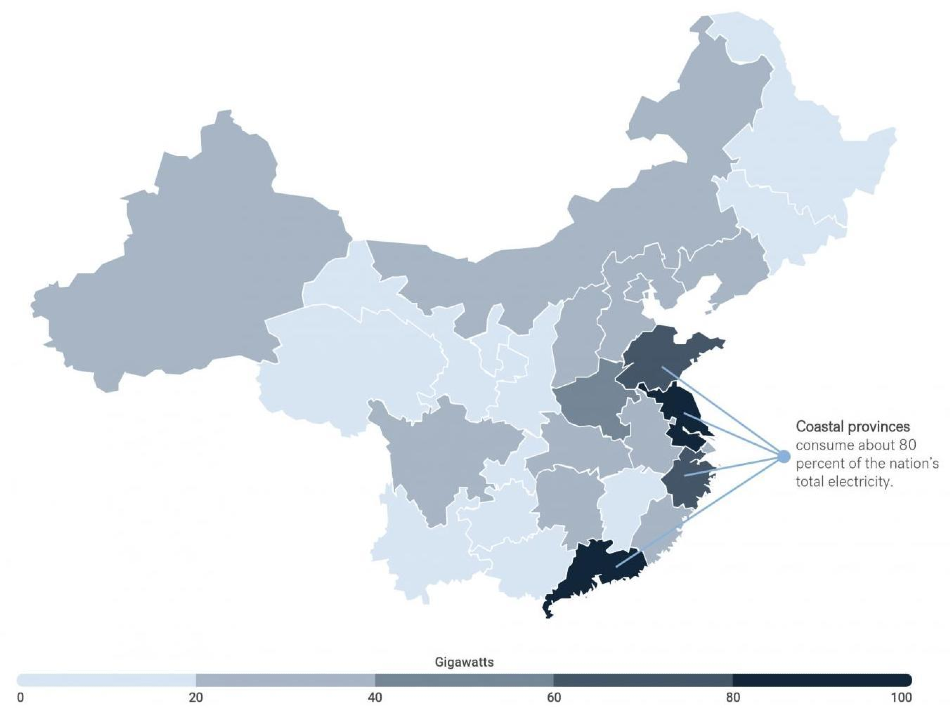Feb 24 2020
In accordance with the Paris Climate Agreement, China has pledged to depend on renewable resources for 20% of its energy demands by 2030. At present, the country is making good progress toward doubling that commitment, with the goal of achieving 40% within the next 10 years.
 This map shows electricity demand by province in gigawatts. Image Credit: Harvard SEAS.
This map shows electricity demand by province in gigawatts. Image Credit: Harvard SEAS.
Wind power plays a crucial role in achieving that aim. In the last two decades, wind power capacity of China has increased significantly from 0.3 to 161 gigawatts. However, in the recent past, that growth has become very gradual and the aspirations for China’s wind-powered future have been largely curbed. This is because of the lack of viable locations.
The most populated coastal provinces, such as Jiangsu and Guangdong, consume nearly 80% of the overall electricity in China; however, a major portion of the country’s wind capacity is from land-based wind farms in places like Inner Mongolia, located over thousand miles away from most important cities.
Still worse, the latest climate studies have indicated that the weakening land-sea temperature gradient caused by global climate change has been turning historically windy regions, such as Inner Mongolia, less windy.
Moreover, a great portion of the wind power from those regions is not being used due to the time at which it is produced. Studies have proposed that nearly 16% of total potential wind production was wasted from 2010 to 2016, leading to a loss of more than $1.2 billion.
To fulfill and surpass its Paris goal by 2030, China must find a solution to ramp up its wind capacity.
As part of a recent study, scientists at the Harvard John A. Paulson School of Engineering and Applied Sciences (SEAS) and Huazhong University of Science and Technology in China determined that offshore wind could be a huge part of the solution. The study was reported in the Science Advances journal.
This is an important new contribution, recognition that China has abundant off-shore wind potential that can be developed and brought on shore to the power hungry coastal provinces at costs competitive with existing coal-fired polluting power plants.
Michael McElroy, Gilbert Butler Professor of Environmental Studies, Harvard SEAS
McElroy is the senior author of the study.
The researchers resorted to calculating the cost and capacity of offshore wind in China by first determining the regions in which it is feasible to build offshore wind farms. For this, environmentally protected areas, water depths greater than 60 m, and shipping zones were excluded. The wind speeds in those areas were calculated and the hourly capacity for each of the turbines was predicted.
The researchers ascertained that the total potential wind power produced from wind farms set up along the Chinese coast is 5.4 times larger compared to the existing coastal demand for power.
We estimate offshore wind costs according to a range of values derived from recent offshore wind farm developments. Offshore wind turbines have historically been prohibitively expensive, but it is clear now that, because of significant technological advances, the economics have changed such that offshore wind could be cost-competitive now with coal and nuclear power in China.
Peter Sherman, Graduate Student, Department of Earth and Planetary Science
Sherman is the first author of the study.
The researchers predicted that if electricity costs are high, offshore wind could offer over 1,000 terawatt-hours, or nearly 36% of the entire coastal energy requirements. In case electricity costs are less, it could offer over 6,000 terawatt-hours, or 200% of the total energy demand.
Our research demonstrates the potential for cost-effective, offshore wind to power coastal regions, reduce greenhouse gas emissions and improve air quality in China.
Michael McElroy, Gilbert Butler Professor of Environmental Studies, Harvard SEAS
The Harvard Global Institute, National Science Foundation China, and the State Key Laboratory on Smart Grid Protection and Operation Control supported this study.